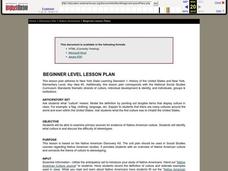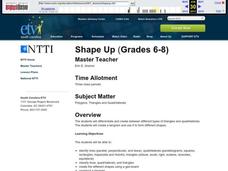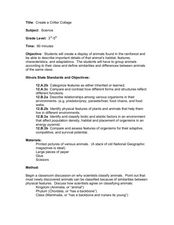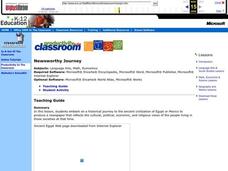Curated OER
Introduce /D/
Students identify the letter sound, "d." In this sound fluency lesson, students view the letter "d" and practice repeating the sound. Students identify the sounds of 12 letters written on the board and are given hints on how to...
Curated OER
Native Americans
Students are be able to examine primary sources for evidence of Native American culture. They identify what culture is and discuss the difficulty of stereotypes. Students are given examples of different cultures.
Curated OER
Life Cycle of a Salamander
Third graders examine the life cycle of a salamander. In this life cycles lesson, 3rd graders view a PowerPoint presentation about the life cycle of a salamander. Students take the temperature of a toy salamander with a thermometer and...
Curated OER
Meeting in the Middle
Young scholars view a video clip about the building of tunnels. They discover the importance of measurement and communication between groups when building a tunnel. They participate in an activity in which they must communicate with...
Curated OER
Shape Up
Middle schoolers explore differents types of triangles and quadriaterals. In this polygon lesson, students model identify and compare two and three dimensional geometric figures. Middle schoolers create tangrams and discover the...
Curated OER
The First American Party System: Federalists and Democratic-Republicans: The Platforms They Never Had
Students investigate the beginnings of the political party system in the US. They determine the key positions of both the Federalists and the Democratic-Republicans. They compare the views of the early political parties with those of today.
Curated OER
Absolute Location
Fifth graders examine the geographic concept of absolute location. Using a variety of resources, they create a life-size classroom grid and locate the coordinates of a point, identify latitude and longitude of different locations, and...
Curated OER
Animals, Soil, Trees
Fourth graders describe the various kinds of soils and how plants and animals are affected by them. They describe the baic needs of plants, scoring at least a 3 or 4 on a 4-point rubic. Students are able to predict and/or infer what...
Curated OER
Create a Critter Collage
Young scholars create a collage. In this animal classification lesson, students discuss why and how scientists classify animals. Young scholars view pictures of different animals and decide which class each animal belongs to. Students...
Curated OER
Electricity's Attraction
Students explore the different features of a roller coaster using an interactive website. In this physical science instructional activity, students explain the role of science to make this thrill ride possible. They develop a creative...
Curated OER
Stars and Constellations
Ninth graders investigate how ancient cultures viewed their world in terms of astronomy. They read and discuss an informational handout, construct an astrolabe, and locate stars and constellations using star charts.
Curated OER
Mastering the Keyboard
Sixth graders view an animated program showing how the continents fit together millions of years ago. In groups, they compare and contrast the distribution of rocks and fossils based on how the continents fit together. After reading a...
Curated OER
Big Cat Locations
First graders explore different environments while studying the habitats of big cats. In this big cats lesson plan, 1st graders draw pictures of their favorite cats, learn about the areas where cats live, design a zoo habitat and...
Curated OER
Flying Casanovas
Students view a video clip on bowerbirds. They research and compare and contrast the different types of bowers created by them. They work together to answer questions on the birds behavior.
Curated OER
Time Zones
Students solve time zone problems and chart travel around the world. In this time zone lesson, students learn about the history of time zones and view a time zone map. Students use the time zone map to solve time zone...
Curated OER
The Power of the Plug: How Electricity Will Change Our Lives... Again
Students study electricity. In this physics lesson, students review electrical energy by discussing three ways of generating it. Students explore various energy sources used for creating electricity and examine how different states...
Curated OER
Matter in Motion
Second graders examine matter, what it is and what the different states are. In this matter lesson students view The Magic School Bus Meets Molly Cule and answer questions.
Curated OER
Newsworthy Journey
Students conduct Internet research about ancient civilizations to produce a newspaper that reflecting the cultural, political, economic and religious views of the ancient civilizations of Egypt or Mexico.
Curated OER
Katrina Case Study
Students explore the impact natural events have on the environment, specifically the wetlands. They view a video about the impact of Hurricane Katrina on the Mississippi Delta and answer discussion questions.
Curated OER
My Feelings!
In this feelings worksheet, students view ten pictures of people showing different types of feelings the left of the worksheet and match the pictures with the actual words on the right.
Curated OER
Creating Rose Windows
Students view a multimedia presentation to recognize rose windows and quilting patterns. In this rose window perimeter lesson, students design rose window from paper. Students review prior knowledge of lines and how they create shapes.
Curated OER
Chemical Change in the Kitchen
Students examine chemical changes to food. In this chemical changes lesson, students make foods and observe the changes. The changes are recorded in an observation journal. Students photograph food they make at different stages in the...
Curated OER
Reflect on this Mote of Dust
Students explore space science by analyzing a speech by Carl Sagan. In this cosmos activity, students view an online video of a speck of a "pale blue dot" in the distance of space which turns out to be Earth. Students write an essay...
Curated OER
Cartoons for the Classroom: Tooning into the Candidates, Hillary Clinton
In this current events worksheet, students analyze a political cartoon about Hillary Clinton and respond to 3 talking point questions.



